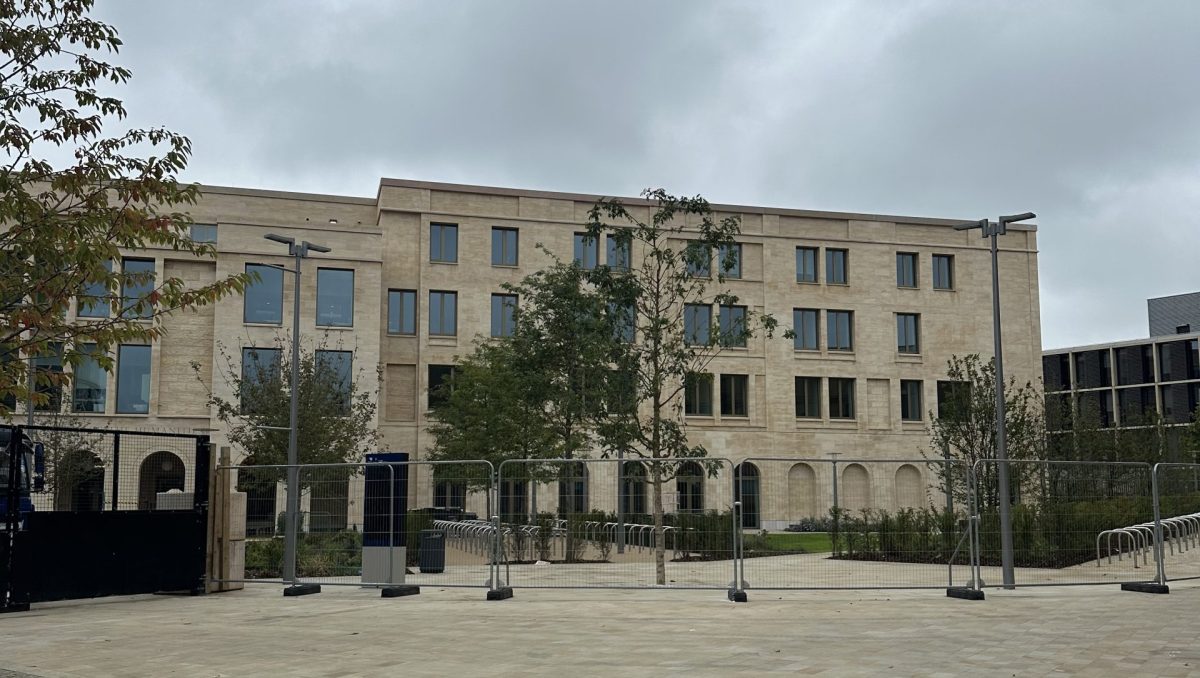This article is based on information delivered to the SCR, MCR and JCR of Somerville College by a representative on the capital building project board for the Schwarzman Centre.
If you’re a humanities student, you have undoubtedly already received multiple emails about the Schwarzman Centre. For the majority of students, Oxford was but a dream when the centre was first announced in 2020. Construction began in October 2022 and after three years, the Stephen A. Schwarzman Centre for the Humanities has finally been completed (on budget and on time!) and will be officially open to the academic community as of 13th October 2025 – although the same cannot yet be said for its website.
Named after the controversial Stephen A. Schwarzman, CEO of Blackstone Inc, the world’s largest alternative investment firm, the centre is the biggest building project in the University’s history. Sitting in the Radcliffe Observatory Quarter (ROQ), the Schwarzman Centre occupies the site of another building gifted by a philanthropist – the old site of the Radcliffe Hospital, which operated between 1770 and 2007. The site was sold in March 2003 after the hospital was made redundant by the bigger John Radcliffe Hospital in Headington, a site now familiar to all medical students and anyone who’s gone a little too far on a night out.
The site also has even older historical roots. From 2009 to 2010, archaeological research found Bronze Age/Neolithic burial grounds which spread across ROQ towards University Parks. These are not the only graves in the area. Between 2013 and 2014, archaeological research discovered a total of 348 paupers’ graves, densely packed underneath where the Blavatnik School of Government now stands. The graves date from the 17th/18th centuries, and causes of death include printing press and train crash injuries, as well as a few cadavers, which would have been used in medical teaching. The Schwarzman Centre intends to honour this history through information boards in the gardens – wonderful news for all the procrastinators who will be using the centre’s new libraries.
Whilst the building will be open to the public, it will also house almost every humanities faculty, with the exceptions of Classics, Asian and Middle Eastern Studies (AMES), and the Ruskin School of Art. It will house seven faculty libraries in its “humanities library”, resulting in the redundancy of humanities faculty libraries, with the notable exception of the Taylorian Institute (which holds the library for modern European languages and literature). The iconic Radcliffe Camera, which functions as the History Faculty library, will also remain open.
In good news for the artistic side of Oxford, the Schwarzman Centre will also be equipped with a soundproof concert hall, a 250-seat theatre, a black box theatre, and a recital studio, all housed in the basement of the centre. This will be soft-launched in February 2026 with student productions, with the intent to invite and commission performances from April 2026. The space will also be used as a lecture theatre, primarily for the English Faculty.
The ground floor will house a cinema, cafe, exhibition hall, TV studio, schools and public engagement centre, Ethics in AI public engagement space, and the Bate Collection of Musical Instruments. It has been made clear that the cafe will be open to all – the intention is to create a social space without the necessity of being a paying customer (and suddenly, it has become even harder to justify that £4 matcha…). As well as three areas around the building serving food and drink, the space will have plenty of desks for those who want a quiet, but not silent, study space. There is hope that student and staff filmmakers will use the cinema.
Whilst the official line is that this centre will offer something new, many of these spaces already exist in Oxford. The upper floors of the Schwarzman Centre will hold the humanities faculty hubs, with seminar rooms and academic offices. The Oxford Blue asked whether the board behind the Schwarzman Centre has thought about the cost to student societies if the space offered by faculties – often free of charge – is lost. The representative answered that the board is looking into absorbing some of these costs for student societies – whether or not this is put into practice remains to be seen.
The Schwarzman Centre has placed an emphasis on being as sustainable as possible, and also an emphasis on its Ethics in AI facilities. Perhaps this is to offset the much-criticised decision to name the building after Stephen Schwarzman. The representative of the board said that whilst the decision has been criticised, the donation from Schwarzman will do a lot of good for the humanities at Oxford, and that whilst it is understood that some people will be hesitant to use the building, there is hope that the centre is more than the name above the door. In all fairness, Oxford is full of places named after figures more controversial than Stephen Schwarzman – but does this mean that we should allow this tradition to continue? Perhaps this will be a question answered by the utility of the building – it may prove itself worth the controversy.
With this new building, added to the Maths Institute, Jericho Health centre, and Blavatnik School of Government, the Radcliffe Observatory Quarter will now function as a new centre of Oxford. This is an interesting turn of events – the new centre of Oxford will be close to the former women’s colleges (with the exception of St Hilda’s), built specifically away from the centre of Oxford. When Somerville, St Anne’s, St Hugh’s and Lady Margaret Hall were first built, the intention was geographical separation of the sexes. With these colleges now co-educational, and a significant proportion of faculty libraries now sitting between Somerville and St Anne’s, perhaps this building will mark a new chapter in Oxford’s thousand-year history.

